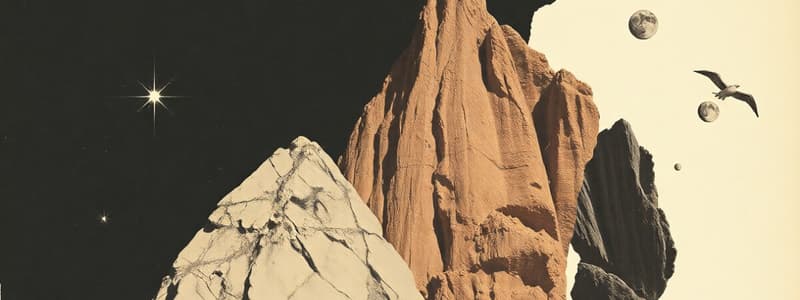Podcast
Questions and Answers
What is the primary component that makes up the majority of rocks on Earth?
What is the primary component that makes up the majority of rocks on Earth?
- Iron and aluminum
- Calcium and hydrogen
- Oxygen and silicon (correct)
- Carbon and sulfur
Which type of rock is formed when molten rock is extruded onto surrounding land?
Which type of rock is formed when molten rock is extruded onto surrounding land?
- Sedimentary rock
- Igneous rock (correct)
- Metamorphic rock
- Basaltic rock
What geological process is primarily responsible for the majority of mountain formation?
What geological process is primarily responsible for the majority of mountain formation?
- Glacial movement
- Erosion of sediment
- Volcanic activity
- Tectonic plate interaction (correct)
How do sedimentary rocks typically appear visually?
How do sedimentary rocks typically appear visually?
Which mountain is known for slowly growing as two tectonic plates press against each other?
Which mountain is known for slowly growing as two tectonic plates press against each other?
What characteristic do gemstones possess that makes them valuable?
What characteristic do gemstones possess that makes them valuable?
What is the term for smaller geologic formations compared to mountains?
What is the term for smaller geologic formations compared to mountains?
Which of the following statements about metamorphic rock is true?
Which of the following statements about metamorphic rock is true?
What process is referred to as orogeny?
What process is referred to as orogeny?
How are fault block mountains primarily formed?
How are fault block mountains primarily formed?
What distinguishes hotspot mountains from other types of mountains?
What distinguishes hotspot mountains from other types of mountains?
Which type of mountain is formed through magma that does not erupt?
Which type of mountain is formed through magma that does not erupt?
Which mountain formation type is caused by the collision of two continental tectonic plates?
Which mountain formation type is caused by the collision of two continental tectonic plates?
What is primarily a result of slow erosion leading to differences in elevation?
What is primarily a result of slow erosion leading to differences in elevation?
Which of the following is NOT a characteristic of subduction?
Which of the following is NOT a characteristic of subduction?
Flashcards
Mountain Formation
Mountain Formation
Mountains form when tectonic plates collide.
Tectonic Plates
Tectonic Plates
Large, moving pieces of Earth's crust.
Igneous Rock
Igneous Rock
Rock formed from cooled magma (molten rock).
Sedimentary Rock
Sedimentary Rock
Signup and view all the flashcards
Metamorphic Rock
Metamorphic Rock
Signup and view all the flashcards
Continental Plates
Continental Plates
Signup and view all the flashcards
Mountain Composition
Mountain Composition
Signup and view all the flashcards
Mount Everest Growth
Mount Everest Growth
Signup and view all the flashcards
Orogeny
Orogeny
Signup and view all the flashcards
Fold Mountains
Fold Mountains
Signup and view all the flashcards
Fault-block Mountains
Fault-block Mountains
Signup and view all the flashcards
Volcanic Mountains
Volcanic Mountains
Signup and view all the flashcards
Dome Mountains
Dome Mountains
Signup and view all the flashcards
Hotspot Mountains
Hotspot Mountains
Signup and view all the flashcards
Subduction
Subduction
Signup and view all the flashcards
Study Notes
Mountain Formation
- Mountains are high geologic features rising above surrounding land.
- Hills, mounds, and plateaus are smaller, similar formations.
- Mountains are composed of various rocks, metals, minerals, and gemstones, varying by location.
- Rocks are made of minerals, which are made of elements.
- Gemstones are minerals with special properties creating value.
- Rocks on Earth primarily consist of oxygen and silicon.
Types of Mountain Rocks
- Igneous rock: Forms when molten rock (magma) cools and hardens, often having a smooth texture. Formed by volcanic activity.
- Sedimentary rock: Forms from compressed sediment (small rocks). Shows layered structures.
- Metamorphic rock: Forms when igneous or sedimentary rocks undergo changes due high pressure or heat.
How Mountains Form
- Most mountains are formed by the collision of continental tectonic plates.
- Plate collision can occur rapidly, like a crash, or gradually over time, causing continuous growth.
- Mount Everest rises approximately 0.16 inches yearly due to the pressure of converging Eurasian and Indian plates.
- Mount Everest also moves slightly north, about two inches annually, due to uneven pressure.
- The Himalayas are examples of fold mountains, formed where plates collide.
Orogeny
- Orogeny: Scientific term for mountain formation.
- Mountain formation is typically caused by tectonic plate interaction at plate boundaries.
- Volcanoes can also cause mountains, through buildup of erupted material.
Major Mountain Types
- Fold Mountains: Form when two continental plates move toward one another.
- Fault-Block Mountains: Form when faults in Earth's crust force rock upwards, resulting in steep cliffs.
- Volcanic Mountains: Form from repeated eruptions from a single vent, building up layers of igneous rock. Example: Mount Fuji.
- Dome Mountains: Magma rises close to the surface, but doesn't erupt; cools and hardens into a dome shape.
- Erosion Mountains: Form slowly through differential erosion, with some rock materials worn away faster than others.
- Hotspot Mountains: Form when magma rises from deep within the earth and the land moves/erodes over it. Not found at plate boundaries, Example: The Hawaiian islands.
- Some mountains are found at the boundary of ocean plates, not necessarily hotspot formations.
Additional Information
- Mauna Kea, measured from base to peak, is the tallest mountain on Earth (33,474 feet).
- The majority of its height is below sea level.
Studying That Suits You
Use AI to generate personalized quizzes and flashcards to suit your learning preferences.




